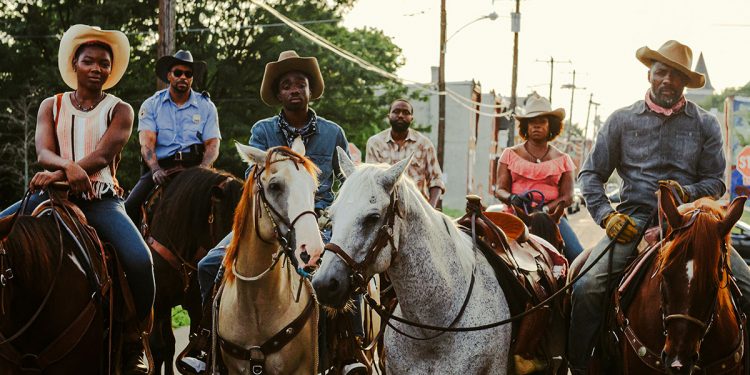There’s a scene in the middle of “Concrete Cowboy” where the film seems to be firing on all cylinders. Most of the sprawling ensemble sit outside – the young and the old. The old are reminiscing about the old days as the youths listen on, halfway between incredulous and doubtful of the stories they hear. The place is North Philadelphia, and the people are the Fletcher Street Riders – an inner-city horsemanship organisation comprised of black urban cowboys. That subject is the film’s greatest hook. Cowboys are a lasting symbol of Americana that has, like many things in American culture, been painted lily-white, removing all the colour from its history.
“Concrete Cowboy”, in parts, offers something of a reclamation. And in that scene, as the camera observes these groups of persons articulating the dissonance between the idea of cowboys in America, and the shared experience of this black community of riders, the film is suddenly loose, and propulsive and warm. Unfortunately, that scene is only a part of “Concrete Cowboy,” which retains its sincerity over the course of its two-hour running time but rarely feels as energetic or dynamic.

Director Ricky Staub makes his feature debut with “Concrete Cowboy,” which straddles two films. The first is a coming-of-age tale of Cole, a troubled teen in Detroit whose mother is at her wits’ end with him. He’s packed off to the streets of Philadelphia with his estranged father and he comes to learn about his father’s place in the Fletcher Street community. Staub’s screenplay (co-written with producer Dan Walser) parallels Cole’s coming-of-age and his flirtations with criminality, against his increasing interest in the ways that the Fletcher Street Riders offer a different idea of blackness in the streets of North Philly. Both of these stories are interesting on their own, but put together in “Concrete Cowboy” the film never seems to sustain momentum in ways that feel as propulsive as they need to be.
Staub seems committed to interrogating a range of issues. Cole’s strained relationship with reticent father Harp is a major arc. As is another arc with his childhood Friend Smush, whose encroaching on a drug dealer’s turf becomes a prominent plot point in the film’s second half. Amidst this, Staub is also interrogating the ways that class and race affect the livelihood of the Fletcher Street Riders, all the while trying to present a thoughtful presentation of a group of people that have rarely been afforded much room in pop culture. “Concrete Cowboy” buckles under the weight of these competing storylines.
The loose and unstructured nature of this points to Staub’s empathy and affection for this story – he cares for all the competing strands of this world. And from moment to moment, we recognise the way his interest in all the parts of this story are manifested in the story’s inability to focus on a concrete through-line. But for all its sincerity, “Concrete Cowboy” feels unsettled in its shapelessness in a way that sometimes cuts against the film’s most earnest emotions. It works best as an anthropological glimpse into a way of life that’s not often examined and that scene of reminiscing in the middle nails the thrill of something that benefits from a gentle openness. Elsewhere, though, it struggles with a plot that seems uncertain about its driving force.
Caleb McLaughlin turns in a committed performance as Cole. It’s a great opportunity for the “Stranger Things” actor to show his ability, and he does well in managing the countering plots. In fact, Staub’s work with his cast is roundly proficient. Jharrel Jerome projects depth to a generic small-time drug dealer in the form of Smush. Idris Elba deepens the opacity of Cole’s taciturn father. But it’s telling how the film’s most resonant performances feel peripheral. Lorraine Toussaint’s knowing neighbourhood mother who cuts through the nonsense with a glance is offering a deft turn in a film that doesn’t know what to do with her. Elsewhere, Jamil Prattis as a wheelchair-bound former rider offers a tender performance that the film cannot always sustain. Prattis is one of a few non-actors from the real Fletcher Street Riders who lend an air of truth to the film.
The coming-of-age leanings mean that “Concrete Cowboy” must end with flirtations with tragedy that help Cole to learn about the world and undergo his metamorphosis into a man. That coming of age, when it comes, does not feel as decisive as it ought to. It does not help that despite McLaughlin’s work, Staub’s script only builds Cole’s initial intransigence in the most generic ways. There’s a confrontation scene opposite Elba that briefly promises something more incisive, but ends too soon as if Staub isn’t committed to tending the emotions of the story. And, it seems indicative of the film’s own uncertainty about what makes this story work. It’s not-quite a western, it feels too indecisive about to be a coming of-age-story, and oddly muted on the father-son dynamic. It’s pleasant, and its emotional beats are well intentioned. As a tale of blackness that eschews the usual tropes, it has its value but the good intentions, a handful of tender moments, and a closing-credits sequence that feels worthy of its own documentary-feature, don’t feel enough to make “Concrete Cowboy” feel like essential viewing.
“Concrete Cowboy” was a Gala Presentation at the 2020 Toronto International Film Festival.





